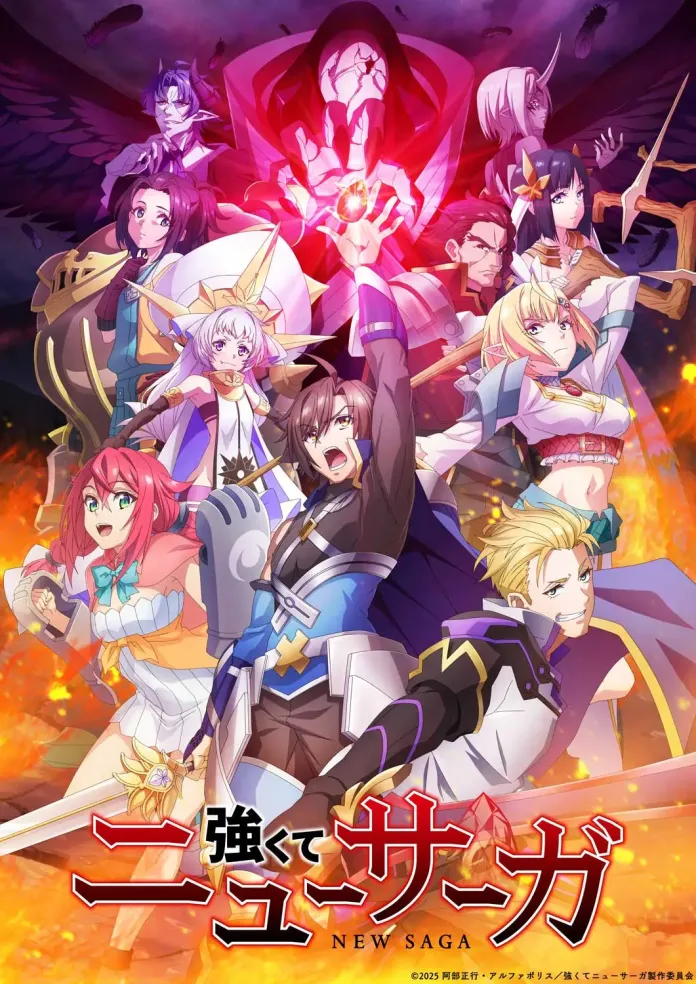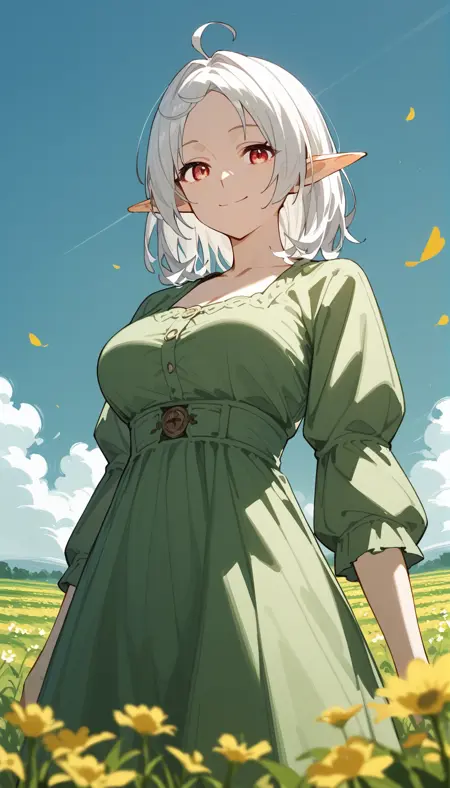Tales of Wedding Rings (結婚指輪物語, Kekkon Yubiwa Monogatari) is a 2024 fantasy-romance anime based on the manga by Maybe, serialized in Monthly Big Gangan from March 25, 2014, to September 25, 2024. Adapted by Staple Entertainment, the series first aired in Japan from January 6, 2024, to March 23, 2024, spanning 12 episodes, followed by a second season released on October 4, 2025.
The anime blends romantic destiny with high fantasy, centring on an ordinary boy who becomes a legendary hero through marriage to a princess — literally. With its enchanting world-building and emotionally charged waifus, Tales of Wedding Rings quickly became one of the most distinctive romantic adventures of its year.
Series Information
| Category | Details |
|---|---|
| Title | Tales of Wedding Rings (Kekkon Yubiwa Monogatari) |
| Genre | Fantasy, Romance, Adventure, Isekai |
| Author / Original Creator | Maybe |
| Director | Takashi Naoya |
| Series Composition | Deko Akao |
| Music Composer | Satoshi Hōno |
| Studio | Staple Entertainment |
| Licensed by | Crunchyroll (English Dub) |
| Season 1 Airing | January 6, 2024 – March 23, 2024 |
| Season 2 Airing | October 4, 2025 – Present |
| Episodes | 12 (Season 1), ongoing (Season 2) |
| Original Network | Tokyo MX, AT-X |
| English Dub Premiere | January 20, 2024 (Season 1), October 18, 2025 (Season 2) |
Synopsis
Satou, an ordinary high-school student, lives a peaceful life — except for his unspoken love for his childhood friend Hime, a mysterious girl of ethereal beauty. When Hime suddenly announces that she must return to her home world to marry another man, Satou impulsively follows her through a portal to a different realm.
At the wedding ceremony, fate intervenes: Hime kisses Satou, declaring him her true groom. With that single act, Satou inherits the title of Ring King, a prophesied hero who draws strength from the mystical Wedding Rings bestowed by princesses of other realms. Together, they must unite the five ring princesses to defeat an ancient darkness threatening their worlds.
What begins as a confession of love transforms into a journey of destiny — a story of bonds forged by loyalty, love, and sacrifice.
Storyline and Pacing
Season 1 introduces the central romance between Satou and Hime, balancing high fantasy adventure with emotional vulnerability. The early episodes focus on world-building — the structure of kingdoms, the lore of the rings, and the bond between king and princess.
Unlike many isekai series, Tales of Wedding Rings never relies on overpowered clichés. Instead, the protagonist’s growth stems from emotional depth and the gradual unlocking of each ring’s power through genuine connection and trust.
Season 2 raises the stakes considerably. The world expands beyond Hime’s realm as Satou must find and wed the remaining Ring Princesses, each representing an element and culture — from the fiery desert lands to the aquatic kingdoms beneath crystal oceans. Themes of faithfulness and moral dilemma take centre stage as Satou’s relationships test the meaning of love and duty.
This structure — romance entwined with world salvation — gives Tales of Wedding Rings a refreshing balance between emotional storytelling and heroic grandeur.
Animation and Art Style
Staple Entertainment delivers an art direction that complements the series’ romantic fantasy tone. The character designs remain faithful to Maybe’s manga — soft lines, expressive eyes, and regal attire evoke both vulnerability and divinity in the princesses.
The world is depicted with vibrant colours and detailed landscapes, from radiant wedding altars to battlefields shrouded in light magic. Action scenes rely on smooth choreography, often enhanced by glowing runes and swirling ring energy that symbolise the merging of love and power.
Lighting and colour symbolism play a major role — Hime’s kingdom is painted in celestial blues and golds, while desert and ocean realms use vivid contrasts to reflect the emotional tension between princesses and Satou. Overall, the production maintains consistent animation quality across both seasons, with several visually stunning climax sequences.
Soundtrack and Voice Acting
Satoshi Hōno’s soundtrack imbues each moment with grand orchestral themes that capture both intimacy and adventure. The opening theme, performed by Saji, is uplifting yet melancholic, representing the bittersweet duality of love and destiny. The ending themes are more subdued, often framed by the emotional aftermath of each episode’s events.
Voice performances stand out — particularly Gen Sato (as Satou) and Akari Kitō (as Hime). Their chemistry drives the series, transitioning naturally from friendship to deep, unspoken affection. The English dub by Crunchyroll successfully preserves this emotional cadence, with well-matched casting that avoids the exaggeration often found in fantasy translations.
Waifu Harem — The Princesses of Rings
The heart of Tales of Wedding Rings lies in its waifus — the Ring Princesses. Each embodies a unique archetype and emotional resonance, making the series a treasure trove for waifu enthusiasts. Below is a breakdown of the primary heroines, their archetypes, powers, and defining characteristics.
Hime — The Light of Devotion (Yamato Nadeshiko)
Princess of the Light Realm and the first bride of Satou, Hime represents purity, loyalty, and unwavering affection. Her serene beauty, silver hair, and calm grace make her the quintessential Yamato Nadeshiko — the ideal Japanese waifu archetype embodying patience and quiet strength.
Though outwardly composed, Hime hides deep fears about burdening Satou with her destiny. Her ring grants Satou the Light of the Kingdom, a power that purifies darkness and strengthens his resolve. She’s the emotional anchor of the series — a symbol of faithfulness transcending worlds.
Why she’s a waifu: Hime combines elegance with vulnerability. Her devotion is not submissive; it’s empowering. Fans are drawn to her ability to balance nobility and humanity — a queen and a lover all at once.
Nephrites — The Jewel of the Desert (Tsundere Warrior)
Introduced in the middle of Season 1, Princess Nephrites rules a desert kingdom bathed in crimson dunes. Proud and fiery, she initially refuses Satou’s proposal, challenging his right to lead. Yet, as their bond deepens, her defensive nature softens into trust and affection — hallmark traits of a Tsundere archetype.
Her ring channels Flame Magic, imbuing Satou’s sword with blazing attacks. Nephrites’s warrior training and independence make her both a rival and protector. Beneath her sharp words lies deep loyalty, and her scenes often provide some of the series’ most passionate confrontations.
Why she’s a waifu: The perfect contrast of strength and femininity. Nephrites embodies the thrill of earning love through mutual respect and emotional breakthrough.
Granart — The Stone Princess (Kuudere Protector)
A stoic guardian of a subterranean realm, Princess Granart exemplifies the Kuudere archetype — calm, rational, and protective. Her world, carved from ancient rock, mirrors her inner solidity. Initially detached, she gradually reveals a gentle, caring side as Satou earns her trust.
Her ring grants the Power of Earth, enabling defensive barriers and regenerative magic. She sees Satou’s emotional honesty as both admirable and frightening, forcing her to confront her own isolation.
Why she’s a waifu: Granart’s quiet loyalty and dignified composure give her a mature charm. She appeals to fans who appreciate restraint, intellect, and emotional subtlety.
Saphir — The Song of the Seas (Dandere Mermaid Princess)
From the ocean kingdom comes Princess Saphir, whose soft voice and shy demeanour represent the Dandere archetype. She communicates through song rather than words, and her compassion extends even to sea creatures.
Her ring controls Water Magic, allowing Satou to manipulate tides and heal allies. Saphir’s story arc in Season 2 explores themes of communication and emotional openness, culminating in one of the most visually poetic weddings in the series.
Why she’s a waifu: Her innocence and empathy awaken the protective instincts in viewers. She’s the embodiment of gentle affection, subtle yet profound.
Amber — The Flame of Spirit (Genki Girl)
Princess Amber enters in Season 2 as the Ring Princess of Fire. Bright, energetic, and full of enthusiasm, she revitalises the party’s morale even in the darkest moments. Her ring enhances Satou’s physical strength and grants the Spirit Blaze, symbolising emotional intensity.
Why she’s a waifu: Amber’s optimism and warmth make her irresistible. As a Genki Girl, she reminds audiences that strength often lies in joy, laughter, and relentless hope.
Themes and Symbolism
Beyond its fantasy adventure, Tales of Wedding Rings thrives on thematic complexity. At its core, it’s a meditation on commitment — literalised through marriage. Each wedding represents a fusion not only of power but of understanding between two worlds, cultures, or emotions.
The series redefines the typical harem structure: instead of frivolous romantic competition, each marriage is symbolic of unity and sacrifice. Satou’s growing circle of wives becomes a metaphor for shared responsibility and the different facets of love — duty (Hime), passion (Nephrites), stability (Granart), empathy (Saphir), and vitality (Amber).
Religious and mythological undertones echo throughout the narrative, from the imagery of rings as eternal vows to the recurring motif of light against shadow. The anime manages to treat its romantic premise with sincerity rather than comedy, distinguishing it from other genre counterparts.
Character Growth and Emotional Depth
Satou’s evolution from an ordinary student to a multi-dimensional hero is handled with nuance. His struggle isn’t about mastering power, but about understanding the emotional weight of connection. Each relationship challenges his sense of identity — is he a lover, a saviour, or both?
Hime, meanwhile, develops from a sheltered princess into a steadfast partner who shares rather than hides her burdens. Her maturity anchors Satou’s impulsiveness, and together they form one of the most balanced romantic duos in recent fantasy anime.
Supporting characters, such as advisors, knights, and rival suitors, contribute to a layered exploration of trust and destiny, ensuring that the emotional tempo never stagnates.
Animation Evolution in Season 2
Season 2 refines what Season 1 built. The animation sharpens, magic sequences expand with richer particle effects, and emotional scenes gain more subtle facial animation. Staple Entertainment clearly invested in visual upgrades — wedding ceremonies, elemental transformations, and climactic battles all possess cinematic quality.
The shift to broader world exploration allows for stunning art direction: coral palaces, volcanic temples, and skyborne sanctuaries diversify the palette while maintaining stylistic cohesion.
Final Verdict
Tales of Wedding Rings transcends its seemingly whimsical premise with depth, artistry, and emotional resonance. It’s an anime that explores love as power — not metaphorically, but literally — while retaining dignity, myth, and sincerity.
Its waifus are not mere archetypes; they are pillars of a single emotional architecture, each representing aspects of devotion, courage, and individuality. Whether you’re drawn by the romance, the fantasy battles, or the allure of divine brides, this series delivers a complete experience.
Verdict: ★★★★☆ (4.5/5)
A visually enchanting, emotionally rich fantasy that unites hearts and worlds alike.














